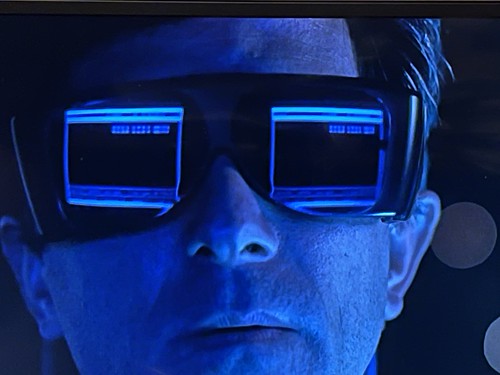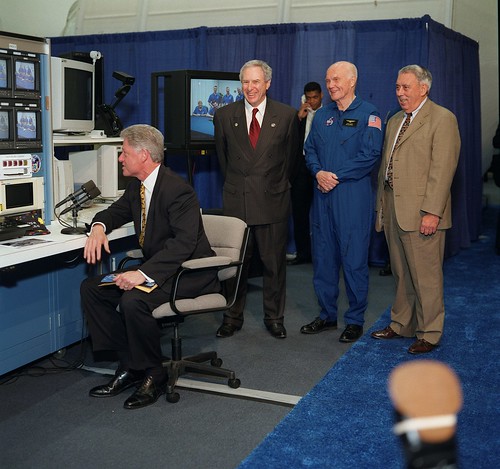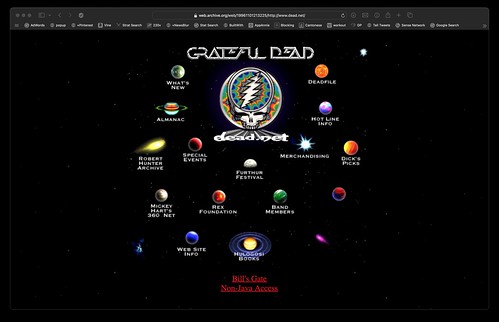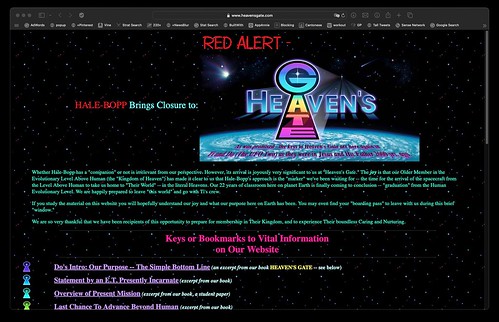10 minutes estimated reading time
Early last year, fashion started to pillage the late 1990s and early 2000s for fashion inspiration, which became a Y2K trend on social platforms and in the fashion media. But this divorced Y2K from its original meaning. Y2K was technologist short hand for a calendar problem in a lot of legacy systems that were designed around a two digit date for years.
The rise of micro-processors had meant that the world had more computers, but also more computer control of processes from manufacturing to building air conditioning systems.
The HBO documentary Time Bomb Y2K leaned into the American experience of Y2K in an Adam Curtis type archival view, but without his narrative.
Millennium layers
There was so much to unspin from the documentary, beyond the Y2K bug, including the largely alarmist commentary. The run-up to the millennium had so many layers that had nothing to do with Y2K, but were still deeply entwined with anxiety around what might happen with Y2K.
This included:
- Internet adoption and more importantly the idea of internet connectedness on culture through the lens of cyberpunk – which in turn influenced the spangliness of fashion around this time and the preference for Oakley mirror shades that looked as if they were part of the wearer. The internet was as much a cultural construct and social object as it was a communications technology. It memed AND then got people online.
- Telecommunications deregulation. In the United States the Telecommunications Act of 1996, saw a levelling playing field be set out and allow for new entrants across telecoms networks to television. They also defined ‘information services’ which internet platforms and apps fitted into giving them many freedoms and relatively few responsibilities. You had similar efforts at telecoms deregulation across what was then the EEC. This saw a rise in alternative carriers who then drove telecoms and data commuunications equipment sales, together with a flurry of fibre-optic cables being laid. There was a corresponding construction of data centres and ‘internet hotels‘ to provide data services. With these services came an expectation that the future was being made ‘real’. Which in turn fed into the internet itself as cultural phenomenon. The provision of new data centres, opportunities for computer-to-computer electronic data interchange (EDI) and services that can be delivered using a browser as interface also drove a massive change in business computing.
- An echo boom of the hippy back to the land movement, many of the people involved in that movement were early netizens. Hippy favourites The Grateful Dead had been online since at least 1996 and were pioneers in the field of e-commerce. The Whole Earth ‘Lectronic Link (or The WeLL) had founders from hippy bible The Whole Earth Catalog. There was also a strong connection through Stewart Brand to Wired magazine. Long time ‘Dead lyricist Jon Perry Barlow created a Declaration of the Independence of Cyberspace – a libertarian totem for netizens up to the rise of social media platforms like Facebook.
- Millennial religious fervour. The Heaven’s Gate cult committed ritual suicide in 1997, and even posted about it on their website. The disastrous FBI showdown with the Branch Davidian cult in Waco, Texas had happened four years earlier and even today is a point of discussion amongst right-leaning Americans.
The confluence of noise around Y2K drove some anxiety and a lot of media chatter.
Advertisers did their bit to fuel insecurities as well.
However by October 1999, American consumers who responded to a poll by the Gallup Organisation were pretty confident that glitches would be unlikely
Y2K: More Signs of the Time | Computerworld (January 10, 2000)
- 55% considered it unlikely ATMs would fail.
- 59% believed direct deposit processing wouldn’t be a problem.
- 60% said they felt that temporary loss of access to cash was unlikely.
- 60% believed credit-card systems were unlikely to fail.
- 66% felt that problems with check processing were unlikely.
- 70% had received Y2K-readiness information from their banks.
- 90% were confident their bank was ready for Y2K.
- 39% said they would definitely or probably keep extra cash on hand.
Experts had felt that the Y2K challenge had largely been beat, but some prudent advice was given. I worked for a number of technology clients at the time including telecoms provider Ericsson and enterprise software company SSA Global Technologies. I had to keep my cellphone with me in case anything went wrong and we would have to go into crisis mode for our clients. Needless to say, I wasn’t disturbed during my night out at Cream by THAT call.
Technology experts like Robert X. Cringely were rolled out to advise consumers on prudent precautions. Have a bit of cash in your wallet in the unlikely event that card merchant services don’t work at your local shop. Have some provisions in that dont need refrigeration in case there is a power cut. And a battery or solar powered radio just in case.
All of these are still eminently sensible precautions for modern-day living.
Why were we ok?
The warning
There were several people who voiced warnings during the 1990s. Some of the most prominent were Ed Yourdon and Peter de Jager.
Risk management
During the 1990s company auditors were informing boards that they had to address Y2K. Failure to follow this would affect their ability to trade. Their public accounts wouldn’t be signed off and there would be implications for the validity the insurance policies need to run a business.
Approaches
IT professionals took Y2K very seriously, which meant that there was little to no impact. Some academics such as UCL’s Anthony Finkelstein posited that the problem was taken too seriously, though it is easier to say that in retrospect. There were a number of approaches taken to combat the risk of failure due to Y2K. In order of least to most ambitious they were:
- Systems testing
- Rip and replace
- Recode
Systems testing
The Russian military had tested their systems for vulnerability to the millennium bug and announced this in the last quarter of 1999. Meanwhile businesses were often passing the testing out to contractors like Accenture with teams based in India, the former Soviet Union or the Philippines. There was a thriving market for auditing software to check if applications used two-digit dates or not. One of these was Peregrine Systems ServiceCenter 2000 Y2K Crisis Management software.
Testing highlighted problems at Oak Ridge Laboratories who process American nuclear weapons, the alarm systems at Japanese nuclear power stations and some kidney dialysis machines.
Problems would then be addressed by ripping and replacing the systems or recoding the software.
Rip and replace
Apple used Y2K as a sales tool to get Macs into businesses, including this campaign from early 1999 where the HAL computer from 2001: A Space Odyssey featured in Apple’s Super Bowl advert.
Two years earlier IBM CEO had the company re-orientate an offering that he called e-business. There was snazzy advertising campaigns ran over an eight year period.
Mainframes and high powered UNIX workstations became internet servers running multiple instances of Linux. IBM Consulting learned as they went building the likes of internet retailer Boxman (which would go bust due to IBM’s cack-handed software and the rise of Amazon).
Timely replacement of business systems with e-business systems, paired with new personal computers like the latest Apple Mac allowed the firm to avoid Y2K and make speedier approaches in digitising their businesses.
German enterprise software company SAP launched SAP Business Connector in association with webMethods in 1999, this provided an integration and migration layer for SAP and other business software applications. It also allowed the business software to be accessed using a web browser and for it to trigger business processes like email updates.
Articles (like Robertson & Powell) highlighted the wider business process benefits that could be generated as part of a move to rip-and-replace existing systems with ones that are Y2K compliant. Reducing the amount of systems in place through rationalisation as part of Y2K preparation would then provide benefits in terms of training and expertise required.
Recode
Where rip and replace wasn’t an option due to cost, complexity or mission criticality recoding was looked at as an approach. For PC networks there were a few off the shelf packages to deal with low level BIOS issues
IntelliFIX 2000 by Intelliquis International, Inc. Their product would check hardware, DOS operating system, and software. This version was free and ran a pass/fail test. The full version, which could be purchased for $79, would report the issues and permanently correct date problems with the BIOS and the CMOS real-time clock. In 1999, Stewart Cheifet of the Computer Chronicles rated the product as a very good all-in-one solution for hardware and software.
National Museum of American History: Y2K collection
Products similar to IntelliFIX included Catch/21 by TSR Inc.
Longtime software makers like Computer Associates and IBM provided large companies with tools to audit their existing code base and repair them. IBM’s software charged $1.25 per line inspected. OpenText estimate that there 800 billion lines of COBOL language code out there. So having one of these tools could be very lucrative at the time.
You might have mainframe code on a system that might not have been altered since the 1970s or earlier. Programmers in the developed world who had skills in legacy languages were looking at the end of their career as more of this work had been outsourced to Indian software factories saw Y2K as a last hurrah.
COBOL is still very robust and runs business processes very fast, so is maintained around the world today.
Y2K impact
Professor Martyn Thomas in a keynote speech given in 2017 documented a number of errors that occurred. From credit card reading failures and process shut downs to of false positive medical test results across the world. But by and large the world carried on as normal.
Academic research (Anderson, Banker et al) suggests that the most entrepreneurially competitive companies leaned hard into the Y2K focus on IT and used the resources spent to transform their IT infrastructure and software. Garcia and Wingender showed that these competitive returns were shown to provide a benefit to publicly listed company stock prices at the time.
There were also some allegations that software companies and consultants over-egged the risks. Hindsight provides 20:20 vision.
IT spending dropped dramatically during 2001 and 2002, and by the middle of 2003 technology started to see replacement of software and equipment bought to address Y2K. But the US department of commerce claimed that was no more than a transient effect on economic growth. This was supported by the Kliesen paper in 2003, which posited that the boom and subsequent economic bust was not as a result of Y2K preparation.
More information
Like It or Not, Gaudy Y2K Style Is Roaring Back | Vogue
These Celebrity Y2K Outfits Weirdly Look Like They’re From 2023 | InStyle magazine
National Museum of American History – Y2K collection
Y2K: a retrospective view by Anthony Finkelstein (PDF)
Replacing Y2K technology boosts spending | The Record (July 28, 2003)
Was Y2K Behind the Business Investment Boom and Bust? Kevin L. Kliesen
What Really Happened in Y2K? Professor Martyn Thomas (April 4, 2017) (PDF)




